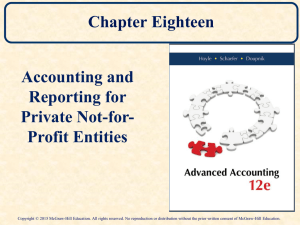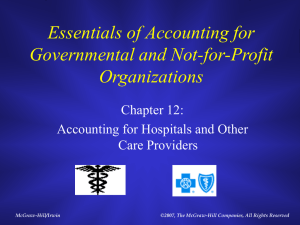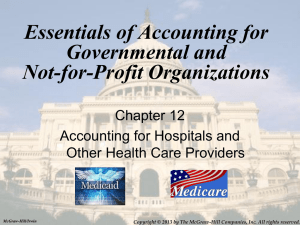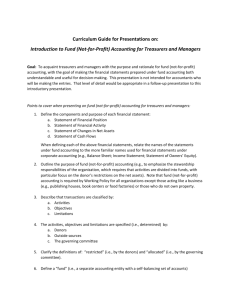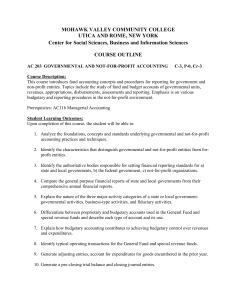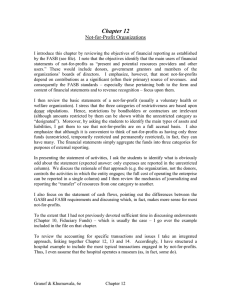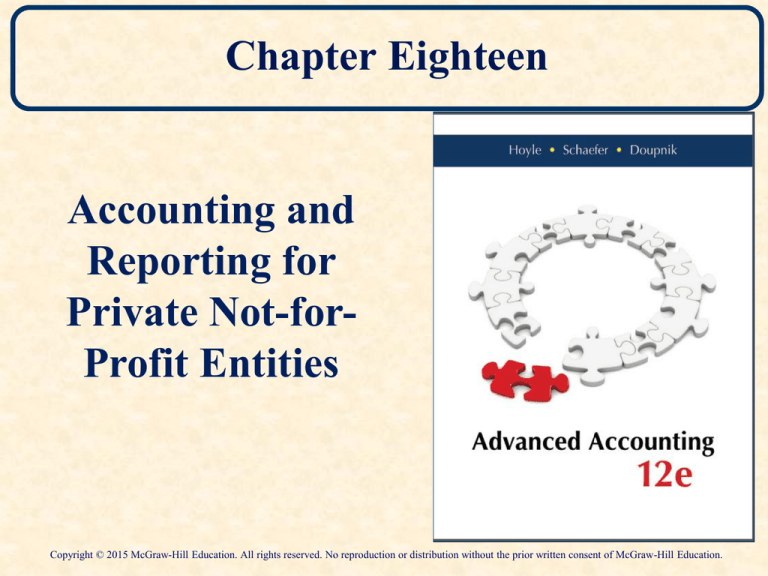
Chapter Eighteen
Accounting and
Reporting for
Private Not-forProfit Entities
Copyright © 2015 McGraw-Hill Education. All rights reserved. No reproduction or distribution without the prior written consent of McGraw-Hill Education.
Not-for-Profit Organizations
General Characteristics
They receive contributions from donors who do not
expect a return of equal financial value
Their operating purpose is not providing goods and
services for profit
They do not have ownership interests as do for- profits
May be governmental or private
Charitable
Educational
Civic organizations
Political parties
Trade organizations
18-2
Charitable Contributions
Recipients of these contributions represent an eclectic assortment
of missions:
18-3
Charitable Contributions
Total estimated charitable giving in the United
States increased 4.0 percent in 2011 from 2010 to
$298.42 billion in contributions from a wide sector:
18-4
Charitable Contributions
The 10 largest charities reported receiving $13.6 billion in
private support in 2012 with total revenues of $29.8 billion.
The entities receive significant revenue from a variety of
sources as a list of the five largest charities demonstrates:
18-5
Learning Objective 18-1
Understand the basic composition
of financial statements produced for a
private not-for-profit entity.
18-6
Not-for-Profit Organizations
Several basic goals form the framework for the
generally accepted accounting principles for private
not-for-profit entities, including:
1. Financial statements should focus on the entity as
a whole.
2. Reporting requirements for private not-for-profit
entities should be similar to those applied by forprofit businesses unless critical differences exist in
the nature of the transactions or the
informational needs of financial statement users.
18-7
Financial Statement Goals
The first goal asserts that the financial statements should
not highlight individual funds the organizations use for
internal record-keeping.
For external reporting purposes, FASB emphasized the
operations and financial position of the entire
organization.
The second goal allows the use of many of the same
accounting techniques utilized by for-profit entities.
Existing authoritative literature for capital leases,
pensions, contingent liabilities, and similar issues have
not been rewritten for private not-for-profit entities.
18-8
Not-for-Profit Organizations
FASB Statement (SFAS) 116, “Accounting for
Contributions Received and Contributions Made,”
established guidelines for determining when and
how donations should be recognized and reported.
FASB Statement 117, “Financial Statements of Notfor-Profit Organizations,” specified the required
content and format for financial statements
distributed by these organizations.
18-9
Learning Objective 18-2
Describe the differences in assets that are
unrestricted, temporarily restricted, or
permanently restricted and explain
the method of reporting these categories.
18-10
Financial Reporting
Three critical differences exist between private not-forprofit and for-profit businesses.
1) Donations received by private entities are
transactions that have no counterpart in commercial
businesses.
2) The private entities’ donations often have donorimposed restrictions.
3) No single figure describes performance as effectively
as net income does for commercial entities.
18-11
Financial Reporting
The differences create the need for a unique set of
financial statements for not-for-profit entities.
FASB requires three financial statements for not-forprofits.
Statement of Financial Position
2) Statement of Activities
3) Statement of Cash Flows
In addition, the Statement of Functional Expenses is
required only for voluntary health and welfare
organizations.
1)
18-12
Statement of Financial Position
Reports assets, liabilities, and net assets.
Uses term Net assets rather than Owners’ Equity.
Restrictions by outside donors results in assets classified as:
Unrestricted
Includes board-designated or internally restricted
assets.
Temporarily restricted (for a particular purpose or for
use in a future time period).
Permanently restricted (expected to remain restricted for
as long as the organization exists).
18-13
Statement of Activities
Reports revenues, expenses, and other changes in net assets.
A separate column presents increases and decreases in
each of the three categories of net assets.
Final totals agree with the net asset balances on the
statement of financial position.
Statement is sometimes labeled as a statement of
changes in net assets.
Primary purpose is to provide a clear picture of
donations received and any attached restrictions.
18-14
Statement of Activities
When a temporary restriction (either time or usage) is
fulfilled, that amount of net assets is immediately
reclassified as unrestricted.
If an expense is incurred to meet a donor stipulation,
both the expense and the contribution appear in the
statement of activities in the Unrestricted column in
the same time period.
18-15
Statement of Activities
All expenses are presented in the Unrestricted Net
Assets column in two categories:
Program Services
Supporting Services
Program Services
Activities relating to social services, research, or other
objectives of the organization.
Supporting Services
Administrative costs and fund-raising expenses.
18-16
Statement of Cash Flows
Statement of Cash Flows
Use the standard FASB classifications
1. Operating Activities
2. Investing Activities
3. Financing Activities
May use either the direct or the indirect methods.
18-17
Learning Objective 18-3
Explain the purpose and
construction of a statement
of functional expenses.
18-18
Statement of Functional Expense
Statement provides a detailed analysis of expenses by
function and object.
Columns represent functions followed by supporting
services.
Categories are the same as those reported on the
statement of activities and column totals agree with
the operating expenses on that statement.
Rows list expenses according to their nature.
Allocation of joint fund-raising & program service
costs is permitted only when certain criteria are met.
18-19
Learning Objective 18-4
Report the various types of
contributions that a private
not-for-profit entity can
receive.
18-20
Accounting for Contributions
Contributions, unconditional transfers of cash or other
resources, are recorded as support at fair value in the
period received.
Restricted gifts are not the same as conditional gifts.
Donors of restricted contributions specify how they are to
be used. These gifts are recognized as temporarily or
permanently restricted assets when a promise is received.
Conditional promises that require a future action before
asset will be transferred from the donor are not
recognized until conditions are met.
18-21
Accounting for Contributions
Donations of works of art and historical treasures
are generally not recognized, but disclosure is
required.
Exchanges, such as member dues, are treated as
accrual revenue.
Contributed services are recognized as revenue if
one of two conditions is met:
1. The service creates or enhances a nonfinancial asset,
OR
2. The services are specialized and would have had to be
purchased otherwise.
18-22
Learning Objective 18-5
Understand the impact of a
tax-exempt status.
18-23
Tax-Exempt Status
Tax-Exempt Status – Not-for-profits may not have to
pay federal income taxes under the following sections
of the Internal Revenue Code:
Section 501(c)(3) applies to charitable, educational
or scientific entities.
Section 501(c)(4) applies to social welfare entities,
referred to as advocacy groups.
Section 501(c)(6) applies to business leagues,
boards of trade, chambers of commerce, etc.
18-24
Tax-Exempt Status
Tax-Exempt Status
Exempt from federal taxes.
Often exempt from state taxes.
Donors receive reduction in their taxable income.
Non-profit postal permit reduces the cost of postage.
Cannot engage in political campaign activity.
A not-for-profit must file a Form 990, Return of
Organization Exempt from Income Tax.
18-25
Learning Objective 18-6
Account for both mergers and
acquisitions of not-for-profit
entities.
18-26
Mergers & Acquisitions
Why have mergers and acquisitions become
prevalent among Not-for-Profits?
Efficient use of resources
Common goals
Efficiencies of size
Rescue suffering charities
Expand one organization’s scope of outreach
18-27
Acquisitions
In an Acquisition, one organization obtains control
over another.
Acquired accounts are reported at fair value.
If total acquisition value is greater than the total
value of identifiable assets and liabilities, excess is
reported as goodwill.
If future operations are expected to by primarily
supported by contributions, the excess value is
reported as a reduction in net assets.
18-28
Mergers
A merger occurs when two or more not-for-profit
entities form a new not-for-profit and turn
control over to a newly created governing board.
The carryover method is applied in reporting for
mergers.
In a merger, the newly formed not-for-profit
records all accounts at their previous book
values as of the date of the merger.
18-29
Learning Objective 18-7
Describe the unique aspects
of accounting for health care
entities.
18-30
Accounting for
Health Care Organizations
Health Care expenditures account for 17.6% of our Gross
Domestic Product, much of which is paid by third-party
payors.
From a financial reporting perspective, these
organizations have no need to compute and report net
income.
However, readers of the financial statements need a way
to measure the efficiency of the entity’s operations.
FASB requires the reporting of a “performance
indicator” to show operational success or failure.
18-31
Accounting for
Patient Service Revenues
Third-party payors, insurance companies, Medicare,
and Medicaid, not the patient, pay some or all of the cost
of medical services received.
Bad debts and fee reductions for health care providers
can be significantly higher than for other kinds of
businesses.
Entities initially record revenue at standard rates.
Amounts that the entity does not expect to collect is
reported in a manner that best reflects the activities
(contra-revenue or bad debt expense).
18-32
Contractual Agreements with
Third-Party Payors
Insurance companies and Medicare establish
contractual arrangements with health care providers
stipulating rates to be paid for specific services.
The entity must write off the difference in the
amount a patient is charged and the amount the
payor will pay in a contractual adjustment account.
For matching purposes, these reductions must be
recognized in the same period that the patient
service revenue is earned.
18-33

